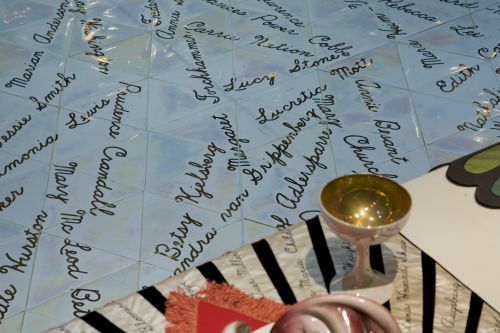Writing Women Back Into History
As I embarked on The Dinner Party Wikipedia project, my first step was to conduct a thorough assessment of the presence of these 1,038 women on Wikipedia. I found that while most of the women included in The Dinner Party are represented, many of them did not have articles of their own (92 of the 999 women named on the Heritage Floor did not). Of those articles that did exist, a significant number qualified as “stubs,” or very short articles in need of expansion and better citation (190 of the 909 articles met this criteria). In thinking about how to move forward with editing existing articles and creating new ones, I came up against several hurdles.
At the launch of the Elizabeth A. Sackler Center for Feminist Art in 2004, the Museum created its own database to complement The Dinner Party, which is still accessible on our website. At the time, independent researchers spent months researching and writing entries for each of the 1,038 women. Of all the issues I encountered in the early stages of this Wikipedia project, the one that most decisively determined the course of the rest of my work was that areas of this database do not provide citations. While the database entries on the Place Setting women are longer and carefully sourced, the Heritage floor entries were created more as placeholders for information that we’d later expand upon, and are therefore typically shorter and do not list any sources.

Judy Chicago (American, b. 1939). The Dinner Party (Heritage Floor; detail), 1974–79. Porcelain with rainbow and gold luster, 48 x 48 x 48 ft. (14.6 x 14.6 x 14.6 m). Brooklyn Museum, Gift of the Elizabeth A. Sackler Foundation, 2002.10. © Judy Chicago. Photograph by Jook Leung Photography
The lack of citations for each of the Heritage Floor entries eliminated the option of directly translating information from our database to Wikipedia. This also had significance for those pre-existing Wikipedia articles that listed The Dinner Party database as a source. By citing the database, which is a tertiary source that does not list any of its sources, the Wikipedia articles were perpetuating a cycle of poorly referenced material. The task became replacing the Brooklyn Museum citation with the original source material.
A more minor problem was the difficulty in finding women on Wikipedia because of multiple or misspelled names. Legendary and mythical figures often have several names, or a name can be spelled differently depending on the transliteration system being used. There were several occasions in which I created new articles only to find that articles already existed under a different spelling of that woman’s name. For example, Judy Chicago’s Flavia Julia Helena was simply “Helena (Empress)” on Wikipedia, and Fibors was found under the name “Tibors de Sarenom.” In these instances, entries were consolidated and multiple aliases were redirected to the same article.
Another issue specific to this project rested in Wikipedia’s notability policy, which states that articles and list topics must be notable, or “worthy of notice”. Determining notability does not necessarily depend on things such as fame, importance, or popularity—although those may enhance the acceptability of a subject. Chicago chose the Heritage Floor women based on many years of extensive research and a rigorous set of criteria for inclusion: “whether the woman made a worthwhile contribution to society; if she had attempted to improve conditions for other women; and whether her life or work illuminated a significant aspect of women’s history or provided a role model for a more egalitarian future.”
This issue was brought up when the article I created for Gisela of Kerzenbroeck, a medieval manuscript illuminator, was nominated for deletion on the basis that the article “lacked context” and was “very incomplete.” I immediately defended the article’s existence on the AfD (Article for Deletion) page, citing the fact that her most notable work, the Codex Gisele, is a significant medieval manuscript and her life and work have been the subject of several published studies. Several other Wikimedians came to the defense of the article and the discussion that ensued is evidence of how exciting the process of writing and editing on Wikipedia can be. Needless to say, the result of the discussion was a “speedy keep.”
I would argue that there is very limited information on many of these historical women because in their lifetimes, their accomplishments were probably deemed unworthy of recording for the sake of posterity. Their accomplishments were also often attributed incorrectly to men. Fanny Mendelssohn, a gifted pianist and prolific composer of the Romantic era, created a musical style that was falsely attributed to her brother, also a famous composer. Oliva Sabuco, a 16th Century Spanish philosopher and author of medical treatises, published a visionary philosophical text in 1587 that, decades later, was attributed to Oliva’s father based on the notion that Sabuco had plagiarized his ideas; recent feminist scholarship has produced compelling counter-evidence of Oliva’s authorship. Genevieve D’Arconville’s 18th Century anatomical drawings, which were the subject of scientific interest for many years, were attributed to a man during her lifetime. The list goes on and on, and many Wikipedia articles still credit these men rather than affording women the credit that is rightfully theirs. Now, we have the opportunity to give these women their due by recording what we know about their lives in Wikipedia, the most public, accessible source available today. It’s an exciting prospect and I look forward to seeing this project through over the next several months.

Alexandra Thom is coordinating a Kress-funded project at the Brooklyn Museum where she works to make scholarly and curatorial information about the Museum’s collections available to the public on Wikipedia. Prior to joining the Museum, Alexandra was the Curatorial Assistant at The Water Tank Project. She is also the co-founder of Archer&Leo, a Brooklyn-based creative agency, and a published author of short fiction. She earned her M.A. from The Courtauld Institute of Art and B.A. from Vassar College.
